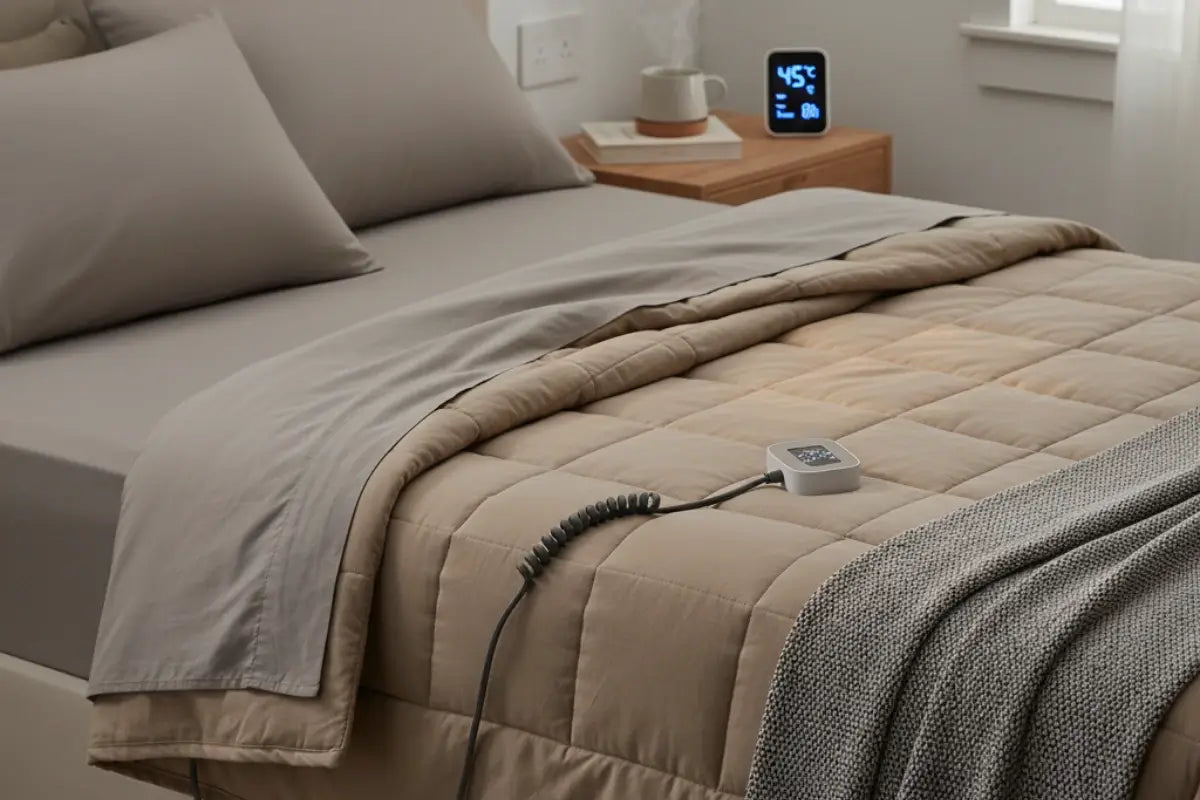5 Reasons You Should Not Use an Electric Blanket While on Oxygen

Using an electric blanket while on oxygen might seem harmless, but it can spark serious dangers.
Even a small malfunction can quickly ignite fires in oxygen-rich environments. Staying warm safely requires smarter choices.
In this article, we’ll explore five important reasons to avoid electric blankets and safer ways to stay cozy at home.
Key Takeaways
Avoid Electric Blankets: Using them around oxygen can easily start fires.
Prevent Sparks: Even small electrical malfunctions are extremely dangerous in oxygen-rich environments.
Follow Safety Guidelines: Medical experts advise never using electrical heating devices while on oxygen.
Stay Warm Safely: Layer blankets, wear thermal clothing, or use microwavable heating pads.
Control Your Environment: Keep oxygen equipment away from heat sources and flammable materials.
Can I use an electric blanket while on oxygen?
Using an electric blanket while on oxygen is extremely dangerous. Oxygen-enriched environments make even small sparks from blankets ignite fires quickly, posing severe burn risks.
Medical experts and safety organizations strongly advise avoiding all electrical heating devices near oxygen.
Safer alternatives include layering blankets, wearing thermal clothing, using microwavable heating pads, or oxygen-safe heaters to stay warm without fire hazards.

5 Reasons You Should Not Use an Electric Blanket While on Oxygen
Electric Blankets Can Start Fires When Oxygen Is Present
Using an electric blanket while on oxygen might seem like a cozy idea, but it carries serious fire risks.
Fire safety organizations, such as the Electrical Safety Foundation International, report that electric blankets and heating pads cause around 500 fires each year.
While some sources suggest higher numbers, official data consistently shows these devices can ignite fires if not used carefully.
The danger rises significantly when home oxygen is involved. The Commonwealth of Massachusetts government explains that extra oxygen in the air, furniture, bedding, clothing, and even hair makes fires start more easily and burn hotter and faster.
Similarly, safety guidance from Mount Sinai highlights that electric blankets, hairdryers, electric razors, and other devices with motors should never be used near oxygen.
Even ordinary household items can become serious fire hazards. In short, using electric blankets around oxygen creates a high-risk environment that could lead to severe burns or devastating fires. Choosing safer alternatives to stay warm is the wisest choice.
Electrical Malfunctions May Ignite Oxygen Quickly
Using an electric blanket while on oxygen can turn a cozy night into a serious hazard. Even a tiny electrical spark can make oxygen catch fire instantly, putting you at risk. Many blankets fail because of frayed wires, worn-out cords, or faulty connections, and these defects can easily ignite oxygen nearby.
Overheating blankets add another layer of danger, especially when thermostats malfunction and fail to regulate temperature.
Compared to other devices, electric blankets carry a higher risk because they stay in direct contact with your body and fabric. Staying aware of these risks keeps you safe.

Oxygen Makes Even Small Sparks Extremely Dangerous
Using oxygen at home can dramatically increase the risk of fire because it creates an oxygen-enriched environment.
In such conditions, everyday items like fabrics, wood, and even skin can ignite more easily, and fires burn hotter and faster than they would in normal air.
A tiny spark from an electric blanket or other heat sources can quickly escalate into a serious blaze.
The National Fire Protection Association reports that home oxygen is linked to hundreds of fires and burns each year, while the Office of Fire Prevention and Control emphasizes that smoking is the leading cause of these incidents.
Medical experts strongly stress safety: never smoke near oxygen, warn visitors to avoid flames, and post “No Smoking” signs prominently.
Keep portable oxygen away from stoves, candles, and heaters, and place cylinders in well-ventilated areas at least eight feet from heat sources.
Following these precautions is essential to protect yourself and your home from preventable, life-threatening fires.
Electric Blankets Can Cause Severe Burns
Using an electric blanket while on oxygen can be extremely dangerous because the extra oxygen makes even small sparks more likely to ignite a fire.
Improper use of electric blankets, like leaving them on too long or folding them, can easily cause burns, and older or damaged blankets increase this risk even more.
Burns can happen very quickly when heat meets oxygen, sometimes before you even realize it. Static electricity from the blanket can also trigger a dangerous flare.
Oxygen therapy doesn’t just help breathing, it can make burns more severe, so avoiding electric blankets is the safest choice.
Using Them Violates Medical Safety Guidelines
The American Lung Association cautions that electric blankets and other electrical heating devices should never be used around supplemental oxygen.
Oxygen itself isn’t flammable, but it strongly supports combustion, making everyday materials ignite more easily and fires spread faster.
Even a small spark from an old or overheated electric blanket can create a serious hazard in an oxygen-rich environment.
Experts, including those at the American Lung Association, recommend safer, non-electric ways to stay warm.
Layering clothing and blankets, wearing thermal pajamas, and using hot water bottles or microwavable heating pads are effective alternatives.
Additionally, insulating your room, keeping oxygen equipment at safe temperatures, and avoiding flammable products like aerosol sprays or petroleum-based lotions can further lower the risk.
Following these guidelines from the American Lung Association ensures that you can stay cozy and safe while using oxygen therapy, preventing accidents while keeping comfort a top priority.
Safer Alternatives to Electric Blankets for Oxygen Therapy Users
Avoid Electric Blankets: They can spark, ignite oxygen, and cause fires.
Microwavable Heating Pads: Provide safe, portable, and reusable warmth.
Layer Traditional Blankets: Use multiple blankets to stay warm without added risk.
Wear Heated Clothing: Choose battery-powered heated vests, gloves, or socks designed with safety in mind.
Low-Heat Mattress Pads: Offer gentle, consistent warmth without fire hazards.
Oxygen-Safe Room Heaters: Use heaters designed without open flames or sparks.
Combine Safe Options: Layer blankets, wear warm clothing, and use safe heat sources together for maximum comfort.





